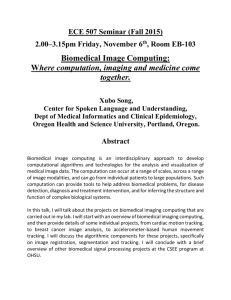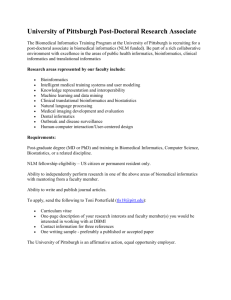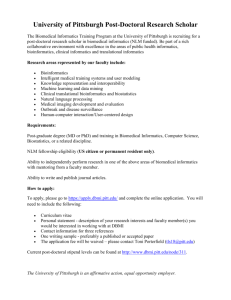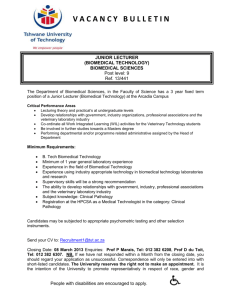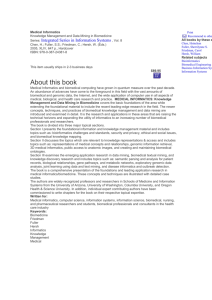Software Engineering Education in Canada
advertisement
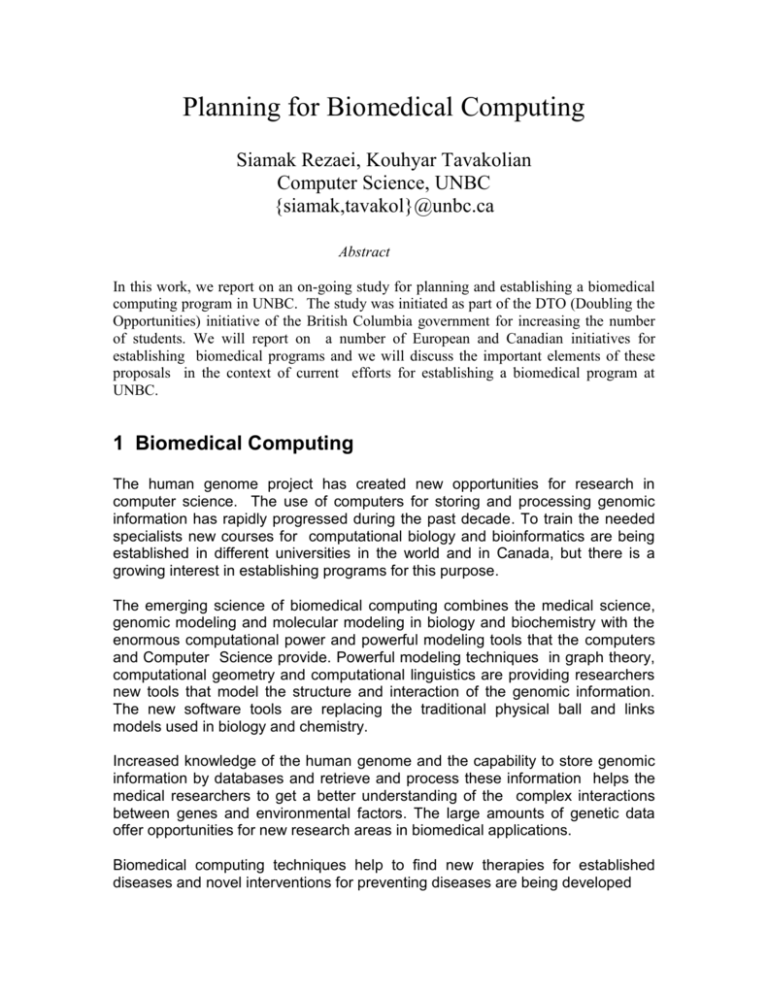
Planning for Biomedical Computing
Siamak Rezaei, Kouhyar Tavakolian
Computer Science, UNBC
{siamak,tavakol}@unbc.ca
Abstract
In this work, we report on an on-going study for planning and establishing a biomedical
computing program in UNBC. The study was initiated as part of the DTO (Doubling the
Opportunities) initiative of the British Columbia government for increasing the number
of students. We will report on a number of European and Canadian initiatives for
establishing biomedical programs and we will discuss the important elements of these
proposals in the context of current efforts for establishing a biomedical program at
UNBC.
1 Biomedical Computing
The human genome project has created new opportunities for research in
computer science. The use of computers for storing and processing genomic
information has rapidly progressed during the past decade. To train the needed
specialists new courses for computational biology and bioinformatics are being
established in different universities in the world and in Canada, but there is a
growing interest in establishing programs for this purpose.
The emerging science of biomedical computing combines the medical science,
genomic modeling and molecular modeling in biology and biochemistry with the
enormous computational power and powerful modeling tools that the computers
and Computer Science provide. Powerful modeling techniques in graph theory,
computational geometry and computational linguistics are providing researchers
new tools that model the structure and interaction of the genomic information.
The new software tools are replacing the traditional physical ball and links
models used in biology and chemistry.
Increased knowledge of the human genome and the capability to store genomic
information by databases and retrieve and process these information helps the
medical researchers to get a better understanding of the complex interactions
between genes and environmental factors. The large amounts of genetic data
offer opportunities for new research areas in biomedical applications.
Biomedical computing techniques help to find new therapies for established
diseases and novel interventions for preventing diseases are being developed
and discussed. The computers are now helping the medical researchers to
design new drugs and simulate the molecular interaction of these drugs.
Computers have come to help the researchers to save and store the vast
amounts of data generated in the laboratory in the areas of functional and
structural genomics and proteomics. Computers also help to create electronic
health records (HER) for clinical decision support systems.
Artificial Intelligence techniques such as neural networks and statistical
classifiers are now widely used for processing the brain EEG signals and to
design new brain computer interface controllers that help the patients with motor
control to communicate with their environment. Tools and techniques in signal
and image processing are now being applied for processing the data in the
emerging discipline of Biomedical Informatics (BMI).
2 Planning for Biomedical Computing
For establishing biomedical computing undergraduate and graduate programs,
new initiatives in Europe and America have been started [1]-[10]. This new wave
in biomedical computing [1] can be compared with an earlier surge of interest in
creating biomedical engineering programs in the 70s after the rapid expansion of
electronic devices and instrumentations in medical science.
The proposals for these programs distinguish between two components of
Bioinformatics (BI) and Medical Informatics (MI). The Medical Informatics (MI)
component is similar to the established programs in health informatics which
contrast with the earlier Biomedical engineering programs. But what are the
main concepts and the main research topics in biomedical computing in order to
develop a curriculum for it.
[1] identifies eighteen research areas for biomedical computing research and
groups them into various categories. Some of these areas are listed:
Databases for clinical annotation and validation of biological data.
Disease reclassification, using molecular and genomic data.
Bioinformatics support for drug design and development.
Genetic data in electronic health records.
Telegenetics and remote health.
Patient profiling based on clinical and genetic information.
Molecular and functional imaging.
Modelling and simulation of cell dynamics and physiology.
Biobanks of a population for disease control.
Another important issue for establishing biomedical programs is the balance
between the two BI and MI components. The majority of the proposals for
biomedical computing do not discuss this balance between the two components
of MI and BI. Should one have a single stream or two streams of BI and MI
inside the same program but with different focus. In the next section, we will look
at one of the first biomedical computing programs in Canada. The program has
been established in Queen’s university and we will discuss the overall structure
and the courses of this program.
2-1 Planning for Bio Medical Computing in Queen’s
Queen’s university has recently introduced the first biomedical computing
program in Canada. Figure 1 and Figure 2 show the different courses of this
program.
CISC-101
Elements of
Computing Sci.I
MATH-111
CISC-121
Intro. to
Computing Sci.I
MATH-121
Linear Algebra
CISC-124
Intro. to
Computing Sci.II
CISC-203
Discrete
Math.
CISC-221
Computer
Architecture
Diff. & Int. Calculus
CISC-271
Scientific
Computing
CISC-124
CISC-235
Data Structures
CISC-223
Software
Specification
CISC-260
Programming
Paradigms
CISC-204
Logic
CISC-235
CISC-325
CISC-322
Software
Architecture
Human - Comp.
Interaction
CISC-235
CISC-340
Digital
Systems
CISC-324
Operating
Systems
CISC-365
Algorithms
CISC-476
System
Simulation
CISC-352
Artificial
Intelligenc
e
CISC-332
Database Systems
CISC-454
Computer
Graphics
BCHM-315
CISC-471
Computational
Biology
CISC- 124
CISC-435
Commun. &
Networks
CISC-124
CISC-457
Image
Processing
CISC-497
Social, Ethical, &
Legal issues
CISC-499
Undergrad
Project
CISC-425
Neural & Genetic.
Computing
CISC-472
Medical
Informatics
MBIO-318
CISC-365
Figure 1: Computer science courses for Biomedical Computing in Queen's
CHEM-112
BIOL-102
Cells
BIOL-103
Organisms
BIOL-205
Genetics
MATH-121
General Chemistry
CHEM-281
Organic
Chemistry I
STAT-263
Introduction to
Statistics
PHGY-214
Physiology
PHAR-230
Pharmacology for
Health Sci.
LISC-322
BIOL-331
Analytical Genomics
MBIO-318
Cell Structure
& Function
BCHM-411
Nucleic Acid
Struct. & Funct
LISC-422
Cell. & Molec.
Neuroscience
PHIL-301
Biomedical Ethics
BCHM-315
Protein & Enzymes
Fundamentals of
Neuroscience
Biochemistry
courses in
Biomedical
computing
program in
Queen's
MBIO-318
CHEM-282
Organic
Chemistry II
LISC-414
Neuroanatomy &
Neuropharm
PHAR-340
General
Pharmacology I
PHAR-416
Enobiotic Disp. &
Toxicity
BCHM-410
Protein
Struct. & Funct.
Figure 2: Biochemistry courses for biomedical computing program in Queen’s
The Queen’s program gives students an education in the fundamental areas of
computer science and life sciences. It also provides a link between these areas
through new specialized courses in medical informatics and computational
biology. The program is a 4 year undergraduate program and the required
courses for this program are highlighted in the previous 2 figures. The figures
show the requirements for each course. Table 1 further highlights the newly
added biochemistry courses1.
Year1
Sem 1A
CS 121
Math111
Bio 102
Physics
Gen ed
Year 2
Sem 1B Sem 2A
CS 122 CS 203
Math121 Chem281
Bio 103
Bio 205
Chem112 CS 260
Gen ed
--
Year 3
Sem 2B Sem 3A
CS 204
CS 223
Chem282 BCHM315
Phyg214 MBio318
CS 235
CS 271
STAT263 Gen ed
Year 4
Sem4A
CS 471
CS 472
Sem4B
CS 497
CS 499
Tech elec
Tech elec
Tech elec
Tech elec
Tech elec
Gen ed
Gen ed
Gen ed
Sem3B
CS 332
CS 352
CS 365
Table 1: Biomedical Computing pattern based on Queen's program
One weakness of this program is the limited number of special courses for
bioinformatics and medical informatics. Most of the bioinformatics programs have
1
We are following the ACM/IEEE patterns used in their publications for proposals for new programs, such
as software engineering. CS corresponds to Computer Science in this table (i.e. CISC courses in Queen’s).
at least two courses for bioinformatics (e.g. see the Alberta program). There is
only one course for medical informatics and the program does not have courses
for biomedical signal processing (even as elective) or medical instrumentation
that can provide a link between the Medical Computing component and the
closely related program of Biomedical Engineering. The link between these two
programs can be compared with the links between Computer Science and
Electrical and Computer Engineering programs.
2-2 Biomedical Computing at UNBC
As part of an initiative in UNBC, we have conducted a survey of recent
proposals and degree programs for biomedical computing. There are no
established body for this program yet and for this study, we have looked at the
European and Canadian proposals for creating biomedical computing graduate
and undergraduate programs. In this work we gave a short survey of these
studies and we plan to propose a biomedical curriculum for an undergraduate
program in UNBC.
Our interest in establishing a biomedical program in UNBC is based on the
recent initiatives by the BC government. The opening of a medical program in
UNBC in Sept 2005 has been a major development by the BC government. The
Doubling of the Opportunities (DTO) initiative of the BC government for
increasing the number of students in Computer Science and related fields has
been another motivation for this study. The DTO five year initiative was initiated
in 2001 in UNBC [2].
The UNBC curriculum will have two streams of bioinformatics (BI) and medical
informatics (MI) and it is expected that the graduates of the program can enter
the medical program at UNBC. This will help the university to compete with other
universities in offering a computing program that smaller universities in BC
cannot provide. Additionally, the medical students can enroll into the program
before being accepted into the UNBC medical program and they can get the
most relevant undergraduate training that helps them later in their medical
carrier.
The introduction of the program in UNBC will benefit from the existing experience
in UNBC in having joint major in Computer Science and Chemistry and joint
major of Biology and Chemistry (biochemistry). In this respect, the bioinformatics
(BI) component of the UNBC program will follow the Queen’s program and other
bioinformatics programs in Canada (e.g. in Alberta). Unlike the Queen’s
proposal, the focus on biochemistry courses will be less2 and a number of
courses for Medical Computing part will be introduced. These will include
courses for biological signal processing and medical instrumentations and they
2
See the Bioinformatics program in Alberta as an example.
will strengthen the Medical Informatics (MI) component of the program.
In
bigger universities such as McGill, where the biomedical engineering program
has already been established, a biomedical computing program can bring a
synergy of research among the different researchers. In universities such as
McMaster and SFU where the biomedical engineering programs are also under
establishment, the biomedical programs can be planned more closely between
the ECE and computer science programs. This does not apply to UNBC, in which
there is no electrical and computer engineering (ECE) program.
For the bioinformatics stream in UNBC, we have introduced a bioinformatics
course at UNBC and graduate researchers are working on bioinformatics topics
in UNBC. With the introduction of a planned interdisciplinary graduate program
in UNBC, we plan to group a number of courses from Computer Science and
Biochemistry programs to create a bioinformatics graduate program in UNBC.
The bioinformatics graduate program and its graduates will help us to bootstrap
the undergraduate biomedical computing program and in a top down approach,
the MSc program helps us to initiate the BSc program in biomedical computing.
For the full implementation of the proposed curriculum, one expects hiring an
additional instructor with biomedical computing experience. If the program is
approved, the remaining courses of the program can be supported by the present
faculty in Computer Science, Biology programs and other programs in UNBC.
Acknowledgment
We would like to thank our colleagues at UNBC for many discussions on this
topic. We also thank Dr Johan Kruger who brought to our attention the existence
of a biomedical computing initiative in Europe.
References
[1] Maojo V, Kulikowski CA, Bioinformatics and Medical Informatics:
Collaborations on the Road to Genomic Medicine? Journal of American Med Inform
Assoc. 2003 Nov–Dec; 10(6): 515–522
[2] Rezaei, S, DTO and Planning for Computer Science and IT Education in UNBC,
Nov 2003 (also appeared in Computer Science DTO Annual report 2003-2004, Nov
2004).
[3] Collins FS, McKusick VA. Implications of the Human Genome,
medical science. JAMA 2001;285(5):540–4.
Project for
[4] Martin-Sanchez, F, The role of informatics in Genomic Medicine. Celebrating 50
years of DNA. Business Weekly; special issue 2003:43–45.
[5] Martin-Sanchez F, Maojo V, Lopez-Campos G. Integrating genomics into health
information systems. Methods Inf Med 2002;41(1):25–30.
[6] Liebman M. From bioinformatics to biomedical informatics, Genome Technol
2001;N11:N64.
[7] De Moor GJE, Iakovidis I, Norager S, Martin Sanchez F. Special Issue on synergy
between research in medical informatics, bioInformatics and neuroInformatics.
Methods Inf Med 2003;42:111–89.
[8] Maojo V, Iakovidis I, Martin-Sanchez F, Crespo J, Kulikowski C., Medical
informatics and bioinformatics: European efforts to facilitate synergy. J Biomed
Inform 2001;34(6):423–7.
[9] Kohane IS. Bioinformatics and clinical informatics: the imperative to collaborate.
J Am Med Inform Assoc 2000;7(5):512–6.
[10] Miller PL. Opportunities at the intersection of bioinformatics and health
informatics: a case study. J Am Med Inform Assoc 2000;7(5):431–8.
